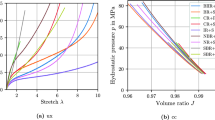Abstract
The hereditary integral form of a quasi-linear viscoelastic law has been employed. Four new concepts have been employed: 1. a reduced relaxation function with a non-linear exponential function of time, 2. an inverse method to determine the scale factor of the elastic response, 3. an instant elastic recovery strain during unloading, and 4. the results of a constitutive model for cyclic tests may be a function of the Heavyside class. These concepts have been supported by agreement between measured and predicted responses of soft connective tissue to three types of multiple cyclic tests which include rest periods of no extension and alternations between different strain levels. Such agreement has not been attained in the previous studies. Chun and Hubbard (2001) is our companion experimental analysis paper.
Similar content being viewed by others
References
Abramowits, M., and Stegun A., 1964, “Handbook of Mathematical Functions,” National Bureau of Standards. Applied Math. Ser. 55, U. S. Government Printing Office, Washington, D. C.
Chun, K. J., 1986, “Constitutive Model of Tendon Responses to Multiple Cyclic Demands, “Dissertation for Ph. D. Degree, Department of Metallurgy, Mechanics, and Materials Science, Michigan State University.
Chun, K. J., and Hubbard, R. P., 1986, “Development of Reduced Relaxation Function and Stress Relaxation with Paired Tendon,”ASME Bioengineering Division 1986 Symposium, ASME Winter Annual Meeting.
Chun, K. J., and Hubbard, R. P., 1987b, “Constitutive Model of Tendon Responses to Multiple Cyclic Demands — II: Theory and Comparison,”the 1987 Biomechanics Symposium (AMD-Vol. 84), ASME.
Chun, K. J., and Hubbard, R. P., 2001, “Constitutive Model of Tendon Responses to Multiple Cyclic Demands(I) — Experimental Analysis-,”KSME International Journal, Vol. 15, No. 7, pp. 1002–1012.
Dale, W. C., 1974, “A Composite Materials Analysis of the Structure, Mechanical Properties, and Aging of Collagenous Tissues,” Ph. D. Thesis, Case Western Reserve University.
Elliot, P. M., 1965, “Structure and Function of Mammalian Tendon,”Biol. Rev., Vol. 40, pp. 342–421.
Fung, Y. C., 1967, “Elasticity of Soft Tissues in Simple Elongation,”Am. J. Physiol., Vol. 213, No. 6. pp. 1532–1544.
Haut, R. C., and Little, R. W., 1972, “A Constitutive Equation for Collagen Fibers,”J. of Biomechanics, Vol. 5.
Hubbard, R. P., and Chun, K. J., 1985, “Mechanical Responses of Tendon to Repeated Extensions with Wait Periods,”Proceedings of the 1985 ASME Biomechanics Symposium.
Hubbard, R., and Chun, K., 1986, “Repeated Extensions of Collagenous Tissue — Measured Responses and Medical Implications,”12th Northeast Bioeng. Conf.
Kastelic, J., 1979, “Structure and Mechanical Deformation of Tendon Collagen,” Ph. D. Thesis, Case Western Reserve University.
Lanir, Y., 1985, “On the Structural Origin of the Quasi-Linear-Viscoelastic Behavior of Tissus,” private communication.
Lanir, Y., 1980, “A Microstructural Model of the Rheology of Mammalian Tendon,”J. Biomech. Engin., Vol. 102.
Mason, R. D., Lind, D. A., and Marchal, W. G., 1983, “Statistics, and Introduction,” Harcourt Brace Jovanovich.
Moursund, D. G., and Duris, C. S., 1967,Elementary Theory and Application of Numerical Analysis, McGraw-Hill, New York.
Parington, F. R., and Wood, G. C., 1963, “The Role of Non-Collagen Components in Mechanical Behavior of Tendon Fibers,”Biochem. Biophys. Acta, Vol. 69, pp. 485–495.
Rabotnov, Y. N.,Elements of Hereditary Solid Mechanics, Mir Publishers, Moscow, 1980.
Rigby, B. J., 1964, “Effect of Cyclic Extension on the Physical Properties of Tendon Collagen and its Possible Relation to Biological Ageing of Collagen,”Nature, Vol 202, pp. 1072–1074.
Rigby, B. J., Hirai, N., Spikes, J. D. and Eyring, H. 1959, “The Mechanical Properties of Rat Tail Tendon,”J. Gen. Physiol., 43, 265–283.
Sacks, M. S., “Stability of Response of Canine Tendons to Repeated Elongation,” Thesis for M. S. Degree, Michigan State University, 1983.
Simon, B. R., Coats, R. S., ad Woo, S. L.-Y., 1984, “Relaxation and Creep Quasilinear Viscoelastic Models for Normal Articular Cartilage,”J. Biomech. Engin. Vol. 106, pp. 159–164.
Viidik, A., “Mechanical Properties of Parallel Fibered Collageneous Tissues,” Biology of Collagen, eds. Viidik, Vuust, Academic Press, London, 1980.
Viidik, A., 1973, “Functional Properties of Collagenous Tissue,” In International Review of Connective Tissue Research, Academic Press, New York and London, Vol. VI, pp. 127–215.
Woo, S. L.-Y., Gomez, M. A., and Akeson, W. M., 1981, “The Time and History Dependent Viscoelastic Properties of the Canine Medial Collateral Ligament,” J. Biomech. Engin., Vol. 103, pp. 293–298.
Yannas, I., 1972, “Collagen and Geltin in the Solid State,”Rev. Macromol. Chem., Vol. C7, pp. 49.
Author information
Authors and Affiliations
Corresponding author
Rights and permissions
About this article
Cite this article
Chun, K.J., Hubbard, R.P. Constitutive model of tendon responses to multiple cyclic demands (II). KSME International Journal 15, 1281–1291 (2001). https://doi.org/10.1007/BF03185669
Received:
Revised:
Issue Date:
DOI: https://doi.org/10.1007/BF03185669




